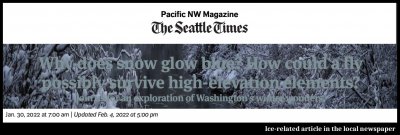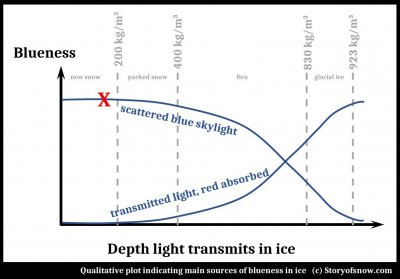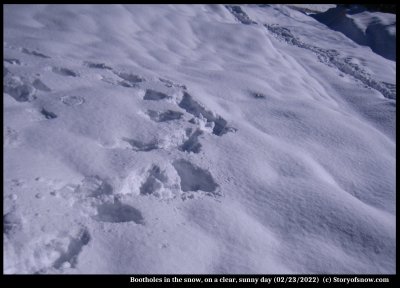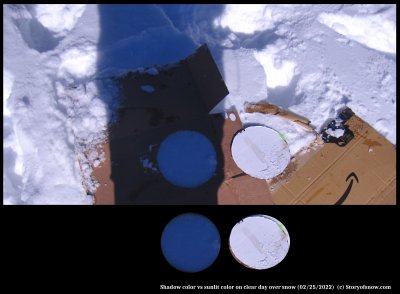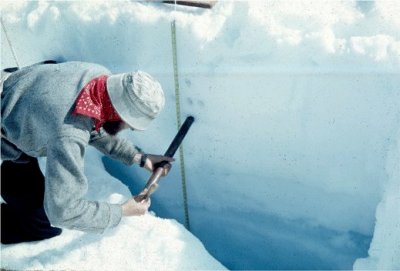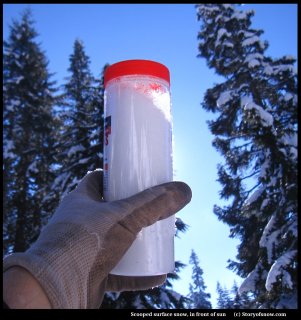| « Why six? | Avalanches, Part 1: Snow Hardening » |
Blues and Whites of Snow and Ice
A recent article in the local newspaper asks the question "Why does snow glow blue?"
The author gave one inspiration for the article as "..the way white snow glows turquoise in the holes left by boots or ski poles..."
The explanation given in the article is the same as that you can find elsewhere on the internet, and certainly applies to glacial ice: absorption of the red end of the solar spectrum upon passing through ice. Does it indeed apply to "holes left by boots or ski poles" in snow?
(The answer is "Not in fresh, light snow, though possible in more compressed or wetter snow." And for some quirk of this blog software, I cannot put the following plot in its proper location further down, so I place it here. Please ignore it for now and refer to it at the end of this post.)
The picture below shows bootholes on relatively fresh snow on a clear day.
As you can see, the shadows at the edge of the holes are indeed bluer than the sunlit snow. (The entire snow surface appears more bluish than I recall, due probably to some automated actions of my Canon digital camera.) However, the bluer color of the shadows is not due to absorption. As proof, see the photo below of flat surface regions in the shade.
The comparison of blue snow in the shade to a white disc and white snow in sunlit regions rules out the explanation of absorption being the cause of blueness.
To better understand the sources of color and processes involved here, consider the following sketch of a person on the shadow side of a snowbank, which may also be the higher side of a crevasse on a glacier.
The person sees only a little of the snow on top of the snowbank. A characteristic ray is marked "1". From the sun, it barely enters the snow and is scattered to the person's eye. This snow looks white. Further down the bank, the person sees ray "2", which is also scattered light, but this ray came from the blue sky, not the sun, so it appears blue. (The sketch gives "blue--white" to allow for the overcast day in which it will also be white.) Lower down, a ray like "3" will likely be much weaker, and hence darker, depending on several factors. If the bank is all snow (and not firn or glacial ice), then essentially no ray will come through. Instead one will see just another version of ray "2". If the bank is mainly glacial ice, then some light such as "3" may make it through with significant absorption of the red. So, it will appear blue. Blue skylight will also contribute blue, but if one is staring deep down into a crack or hole, very little skylight will make it.
You can find real cases of the above ray cases in the following picture of Taku glacier, Alaska (image originally from USGS, and also available from Wikipedia Commons).
The reason why we do not see the case of ray "3" in surface snow is also the reason why surface snow is so white when viewed in sunlight: Nearly all the incident rays are scattered back out. When you try looking for rays coming through, even two inches is too much as shown by the sample I put up to the sun.
A hole in the snow will show some blueness near the top due to skylight, but relatively little skylight reaches into the hole. So, light reaches only near the lip of the hole, and this will be blue. During my outing in the snow above, I brought a post-hole digger to make holes and cardboard to block light paths through the snow (rays "3"). The comparison of the two cases in the picture below show no difference in the color in the hole: All the blueness in the hole comes from skylight, which on this clear-sky day, was blue.
Below the main images, I show rectangular sections from identical regions in the hole. The covered case on the right appears nearly identical to the non-covered on the left. The uncovered may be slightly lighter, an effect perhaps to light reflected off the opposite side of the hole.To summarize, any blue that one sees in ice will depend on several factors, one of which is the ice density. Surface snow is far too porous (low density) and broken up for any light to pass through, whereas solid glacial ice is far denser and allows much greater light transmission.
A quick experiment shows about how much water, in terms of depth, is needed: Start filling a white basin with water. You may detect a distinct blue tint by about three inches of depth, meaning about six inches of transmission (down to the bottom, scatter, and back up to the top). Six inches of water will typically be equivalent to at least three feet of fresh snow. And, as we've seen, you are not going to see any light through three feet of snow. Along the ray path in snow, there is a lot of back and forth, so the three feet will require somewhat less depth, but not enough to change the conclusion.
This suggests the qualitative plot of the source of ice blueness that I tried to post here, but had to place it up at the beginning.
The snow I sampled for the above pictures was about 150 kg/m3, so I marked it on the upper curve only with the red "X". This is a highly simplified and qualitative plot, as many variables involving actual sky conditions and light paths will influence the perceived blueness. Even background colors will play a role. For more on the latter, see reference (1) below.
However, there is a situation in which the color in a boot-hole or ski-pole hole will be bluish even when the sky is grey. If the snow below the surface is quite wet, or at least old and dense, then the whitish light from above that goes into the hole can have some of its light penetrate nearly six inches of water and exit out the same side of the hole. This light will have a bluish tint. In the diagram above, this would be like ray 3, except coming from the same side of the bank as the observer.
Also, the surface smoothness will influence what you see. A chunk of polished glacial ice will have specular reflection off the surface, meaning that the color is the same as the incident's. Away from the reflected spot, the scattering is diffuse and involves some transmission into the surface. Given the low absorption of ice, this too will have the incident's color. If the surface is roughened, then skylight will dominate the color, even for the solid glacial ice. A more in-depth understanding requires a more detailed consideration of the surface.
For other situations in which one sees colors from ice, see my blog entries 1-3 below.
--JN
References and notes
1) Influence of background color, from 2010:
https://www.storyofsnow.com/blog1.php/white-snow-black-snow-pink-snow-blue-snow
2) Polarization colors of ice, from 2009:
https://www.storyofsnow.com/blog1.php/colors-of-ice
3) Also note the colors from refraction, as seen in some arcs, for example, from 2014:
https://www.storyofsnow.com/blog1.php/it-s-not-a-rainbow-it-s-better
